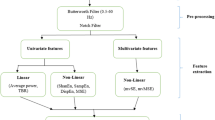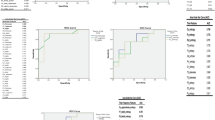Abstract
Purpose
Attention-Deficit Hyperactivity Disorder (ADHD) is a neuro-developmental disorder that is characterized by hyperactivity, inattention and abrupt behaviors. This study proposes an approach for distinguishing ADHD children from normal children using their EEG signals when performing a cognitive task.
Methods
In this study, 30 children with ADHD and 30 age-matched healthy children without neurological disorders underwent electroencephalography (EEG) when performing a task to stimulate their attention. Fractal dimension (FD), approximate entropy and lyapunov exponent were extracted from EEG signals as non-linear features. In order to improve the classification results, double input symmetrical relevance (DISR) and minimum Redundancy Maximum Relevance (mRMR) methods were used to select the best features as inputs to multi-layer perceptron (MLP) neural network.
Results
As expected, children with ADHD had more delays and were less accurate in doing the cognitive task. Also, the extracted non-linear features revealed that non-linear indices were greater in different regions of the brain of ADHD children compared to healthy children. This could indicate a more chaotic behavior of ADHD children while performing a cognitive task. Finally, the accuracy of 92.28% and 93.65% were achieved using mRMR method and DISR method using MLP, respectively.
Conclusions
The results of this study demonstrate the ability of the non-linear features to distinguish ADHD children from healthy children.
Similar content being viewed by others
References
American Psychiatric Association., American Psychiatric Association. DSM-5 Task Force. Diagnostic and statistical manual of mental disorders: DSM-5. 5th edn. American Psychiatric Association, Washington, D.C. 2013.
Meysamie A, Fard MD, Mohammadi M-R. Prevalence of attention-deficit/hyperactivity disorder symptoms in preschoolaged Iranian children. Iran J Pediatr. 2011; 21(4):467.
Jafari P, Ghanizadeh A, Akhondzadeh S, Mohammadi MR. Health-related quality of life of Iranian children with attention deficit/hyperactivity disorder. Qual Life Res. 2011; 20(1):31–6.
King JA, Colla M, Brass M, Heuser I, von Cramon D. Inefficient cognitive control in adult ADHD: evidence from trial-by-trial Stroop test and cued task switching performance. Behav Brain Funct. 2007; 3:42. doi: 10.1186/1744-9081-3-42.
Aboitiz F, Ossandon T, Zamorano F, Palma B, Carrasco X. Irrelevant stimulus processing in ADHD: catecholamine dynamics and attentional networks. Front Psychol. 2014: 4:183. doi: 10.3389/fpsyg.2014.00183.
Mohammadi MR, Malmir N, Khaleghi A. Comparison of sensorimotor rhythm (SMR) and beta training on selective attention and symptoms in children with attention deficit/hyperactivity disorder (ADHD): a trend report. Iran J Pediatr. 2015; 10(3):165–74.
Organization WH. The ICD-10 classification of mental and behavioural disorders: clinical descriptions and diagnostic guidelines. WHO: Geneva; 1992.
Lubar JF. Discourse on the development of EEG diagnostics and biofeedback for attention-deficit/hyperactivity disorders. Biofeedback Self-Reg 1991; 16(3):201–25.
Tansey MA. Brainwave signatures—an index reflective of the brain’s functional neuroanatomy: further findings on the effect of EEG sensorimotor rhythm biofeedback training on the neurologic precursors of learning disabilities. Int J Psychol. 1985; 3(2):85–99.
Tenev A, Markovska-Simoska S, Kocarev L, Pop-Jordanov J, Muller A, Candrian G. Machine learning approach for classification of ADHD adults. Int J Psychol. 2014; 93(1):162–6. doi:10.1016/j.ijpsycho.2013.01.008.
Poil SS, Bollmann S, Ghisleni C, O’Gorman RL, Klaver P, Ball J, Eich-Hochli D, Brandeis D, Michels L. Age dependent electroencephalographic changes in attention-deficit/hyperactivity disorder (ADHD). Clin Neurophysiol. 2014; 125(8):1626–38. doi:10.1016/j.clinph.2013.12.118.
Mazaheri A, Fassbender C, Coffey-Corina S, Hartanto TA, Schweitzer JB, Mangun GR. Differential oscillatory electroencephalogram between attention-deficit/hyperactivity disorder subtypes and typically developing adolescents. Biol Psychiat. 2014; 76(5):422–9. doi:10.1016/j.biopsych.2013.08.023
Fonseca LC, Tedrus GMA, Moraes Cd, Machado AdV, Almeida MPd, Oliveira DOFd. Epileptiform abnormalities and quantitative EEG in children with attention-deficit/hyperactivity disorder. Arq Neuro-Psiquiat. 2008; 66(3A):462–7.
Mueller A, Candrian G, Grane VA, Kropotov JD, Ponomarev VA, Baschera G-M. Discriminating between ADHD adults and controls using independent ERP components and a support vector machine: a validation study. Nonlinear Biomed Phys. 2011; 5(1):5.
Arns M, Gordon E. Quantitative EEG (QEEG) in psychiatry:Diagnostic or prognostic use? Clin Neurophysiol. 2014; 125(8):1504–6. doi:http://dx.doi.org/10.1016/j.clinph.2014.01.014.
Lenartowicz A, Loo SK. Use of EEG to diagnose ADHD. Curr Psychiat Rep. 2014; 16(11):498. doi:10.1007/s11920-014-0498-0.
Zarafshan H, Khaleghi A, Mohammadi MR, Moeini M, Malmir N. Electroencephalogram complexity analysis in children with attention-deficit/hyperactivity disorder during a visual cognitive task. J Clin Exper Neuropsychol. 2015; 1–9.
Khaleghi A, Sheikhani A, Mohammadi MR, Nasrabadi AM, Vand SR, Zarafshan H, Moeini M. EEG classification of adolescents with type I and type II of bipolar disorder. Australasian Phys Eng Sci Med. 2015; 38(4):551–9.
Ahmadlou M, Adeli H, Adeli A. Fractality and a wavelet-chaosneural network methodology for EEG-based diagnosis of autistic spectrum disorder. J Clin Neurophysiol. 2010; 27(5):328–33.
Sadatnezhad K, Boostani R, Ghanizadeh A. Classification of BMD and ADHD patients using their EEG signals. Exp Syst Appl. 2011; 38(3):1956–63.
Higuchi T. Approach to an irregular time series on the basis of the fractal theory. Physica D. 1988; 31(2):277–83.
Petrosian A, Kolmogorov complexity of finite sequences and recognition of different preictal EEG patterns. Proc 8th Comp Med Sy. 1995; 212–7.
Stoica P, Moses RL. Introduction to spectral analysis, vol 1. Prentice hall Upper Saddle River, NJ. 1997.
Principe J, Lo P. Towards the determination of the largest Lyapunov exponent of EEG segments. In: Proceedings of the conference on measuring chaos in the human brain. World Scientific, Singapore, 1991. pp. 156–66.
Röschke J, Fell J, Beckmann P. The calculation of the first positive Lyapunov exponent in sleep EEG data. Electroencephalography Clin Neurophysiol. 1993; 86(5):348–52.
Acharya UR, Vinitha Sree S, Swapna G, Martis RJ, Suri JS. Automated EEG analysis of epilepsy: a review. Knowledge-Based Syst. 2013; 45:147–65.
Peng H, Long F, Ding C. Feature selection based on mutual information criteria of max-dependency, max-relevance, and min-redundancy. IEEE T Pattern Anal. 2005; 27(8):1226–38.
Brown G, Pocock A, Zhao M-J, Luján M. Conditional likelihood maximisation: a unifying framework for information theoretic feature selection. J Mach Learn Res. 2012; 13(1):27–66.
Meyer PE, Bontempi G. On the use of variable complementarity for feature selection in cancer classification. In: Applications of Evolutionary Computing. Springer. 2006. pp. 91–102.
Theodoridis S, Pikrakis A, Koutroumbas K, Cavouras D. Introduction to Pattern Recognition: A Matlab Approach: A Matlab Approach. Academic Press. 2010.
Nelles O. Nonlinear system identification: from classical approaches to neural networks and fuzzy models. Springer. 2001.
Liechti MD, Valko L, Muller UC, Dohnert M, Drechsler R, Steinhausen HC, Brandeis D. Diagnostic value of resting electroencephalogram in attention-deficit/hyperactivity disorder across the lifespan. Brain Topogr. 2013; 26(1):135–51. doi:10.1007/s10548-012-0258-6.
Alba-Sanchez F, Yanez-Suarez O, Brust-Carmona H. Assisted diagnosis of attention-deficit hyperactivity disorder through EEG bandpower clustering with self-organizing maps. Conf Proc IEEE Eng Med Biol Soc, 2010; 2010:2447–50.
Ghassemi F, Hassan Moradi M, Tehrani-Doost M, Abootalebi V. Using non-linear features of EEG for ADHD/normal participants’ classification. Proc Soc Behav Sci. 2012; 32:148–52.
Ahmadlou M, Adeli H. Wavelet-synchronization methodology:a new approach for EEG-based diagnosis of ADHD. Clin EEG Neurosci. 2010; 41(1):1–10.
Author information
Authors and Affiliations
Corresponding author
Rights and permissions
About this article
Cite this article
Mohammadi, M.R., Khaleghi, A., Nasrabadi, A.M. et al. EEG classification of ADHD and normal children using non-linear features and neural network. Biomed. Eng. Lett. 6, 66–73 (2016). https://doi.org/10.1007/s13534-016-0218-2
Received:
Revised:
Accepted:
Published:
Issue Date:
DOI: https://doi.org/10.1007/s13534-016-0218-2




